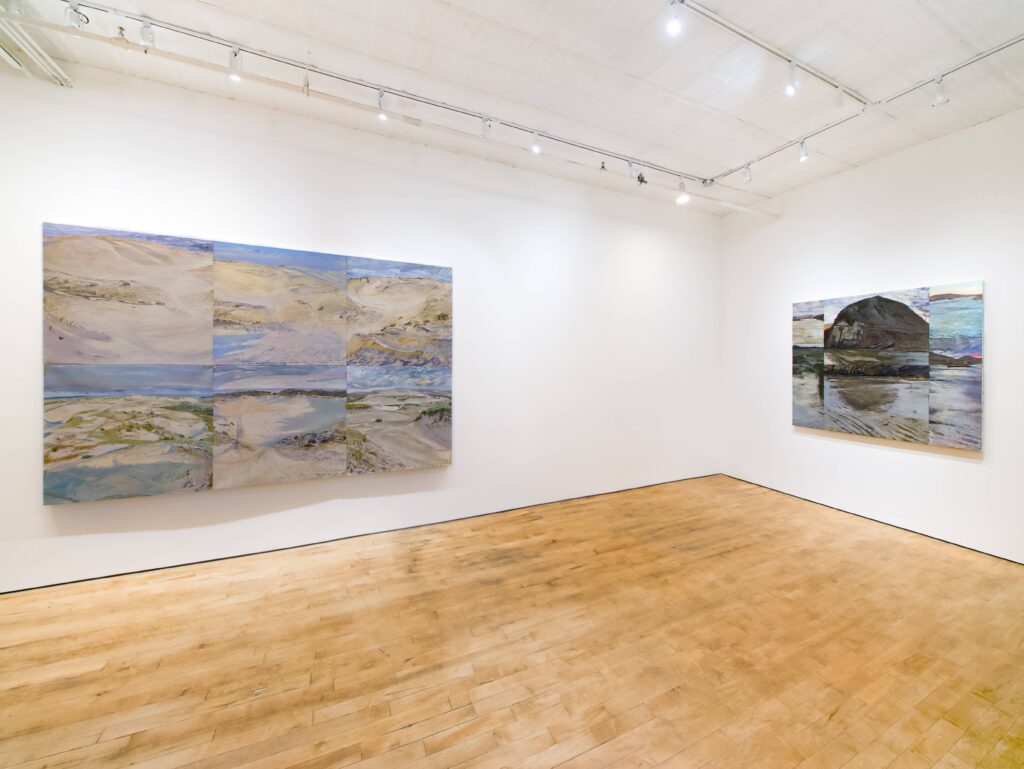Painter Elizabeth Flood’s Plein Air Landscapes Revel in the Immediacy of Perception
Her deftness of touch allows us to almost feel the strong sweep of the wind, the blinding shimmer of the sand, the cyclical retreat and encroachment of light and shadow.

Elizabeth Flood: ‘Lookout’
Storage, 52 Walker Street, 4th Floor, New York, NY
Through May 24, 2024
An amalgam of responses, both intellectual and emotional, inform Elizabeth Flood’s monumental landscapes. Many portray iconic outdoor American scenes from a variety of different perspectives. Coinciding with this week’s Frieze fair, which aims to showcase the best new painting, Ms. Flood’s work is a notable side entry.
Ms. Flood’s painting approach is not only rooted in a deep knowledge of the genre, but is also rooted in the immediacy of perception. She thinks nothing of hiking for hours to find the right spot, in all types of weather, and this can be felt in the fresh immediacy of each one. Ms. Flood is one of the few landscape painters that refuses to work from photographs, insisting, like Cezanne, on the benefits of painting outdoors, en plein air.
However, she interestingly subverts this immediacy by taking several canvases of the same scene from different vantage points and combining them into larger, more monumental compound landscapes. Ms. Flood might be called a painter of “hybrid” landscapes. While each separate canvas is painted with an almost hyper real sensitivity to its particular light and points of view, they combine into something else, an amalgam that verges on abstraction.
Her work is also marked by strict conceptual categories. Her landscapes are American in focus, portraying varied areas of natural splendor and historic significance. She is dedicated to natural sites such as the dunes of Provincetown, Massachusetts, or the Civil War-era landscapes of Gettysburg, Pennsylvania and Chancellorsville, Virginia. She also takes the naturalistic and ecological import of the sites she chooses into consideration.

Influenced by the horizontality of landscape frescoes she first saw at Naples, Ms. Flood became interested in the layered manner landscape was treated in early Italian landscape, charmed by the variety of intriguing effects they provided. After some research she decided that she would only attempt to paint landscapes directly, while in her natural element.
Her strategy also applies to vantage point, elevation and time of day, as well. Ms. Flood will paint each separate canvas from a different spot in the same landscape, oftentimes under different lighting conditions and different weather. She will also paint over an extended period of time. The fresh Immediacy of moment-to-moment perception and the long view are placed side by side.
As in the case of “Dunes,” Ms. Flood hiked out to several different locations of the same landscape over a span of several months, painting with immediacy but also with the intention of piecing everything together later. Her deftness of touch allows us to almost feel the strong sweep of the wind, the blinding shimmer of the sand, the cyclical retreat and encroachment of light and shadow. Hyperreal at a distance but impressionistic up close, it ultimately gives the feeling of traditional landscapes blending together into a larger abstraction.
In other instances, Ms. Flood uses landscape to invoke our shared historical past. Choosing Civil War battlegrounds necessarily invokes our American past in our current fraught and divisive time, when thoughts of a renewed civil conflict don’t seem too terribly far from the national imagination. Ms. Flood uses her usual techniques of surveillance and juxtaposition in these paintings, this time cobbling several battle sites together.
Seen as a single painting, they create one large and lush composite that barely holds itself together, while the whole seethes with energy. The furious greens, where even the skies appear tinged with the lushness of the vegetation, seem to roil. Whether this is symbolic or allegorical is up for grabs, but it appears to tap into an inherent energy in the sites themselves.
She can be piercingly serene as well. Above one of the doors connecting the gallery rooms is an equally striking long study of mountain ranges which, also painted at different times, seem purely engaged in studying different forms and colors of light as it strikes mountains or splays itself out majestically across the sky. The serial formalism of the separate canvases suggests land survey photography, while the magnificence of the vistas themselves evoke Albert Bierstadt.
The show also features her very rigorously worked black-and-white landscape drawings. Again they show off a masterful assurance even as they are denser and more cryptic, leaning towards expressionism if not early fauvism. Despite the thick and brooding cross hatching of charcoal lines, Ms. Flood never fails to convey a sense of a wide open expanse of space.
Landscape is, after all, the conjuring trick by which a massive terrain is made to convincingly appear two-dimensionally on a surface. One never loses the sense of the outdoors with Ms. Flood. You can almost feel the breeze on your skin.
Which is part of Ms. Flood’s impressive balancing act. She incorporates the myriad ways in which land and place can be witnessed: as direct nature, as nation, as historical site, as the history of painting, as a place of mythical settlement, as a fulfillment of collective promise. Land, as it turns out, means a great many things. That something so obvious suddenly strikes the viewer standing in front of her painting is a testament to her approach.
These landscapes are, in other words, much more than the sum total of what they represent on the surface. Ms. Flood, beyond being a technically excellent and compelling painter of landscape, also strives to make the hidden and nested layers of their temporal and cultural meanings explicitly visible.
This article has been updated to clarify the geographic range of Ms. Flood’s work on display.

